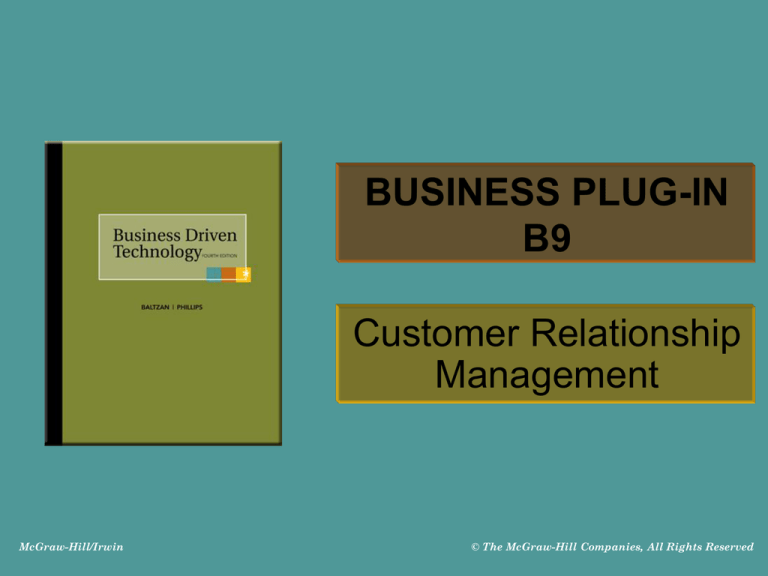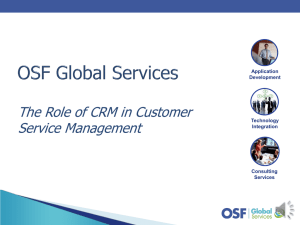
BUSINESS PLUG-IN
B9
Customer Relationship
Management
McGraw-Hill/Irwin
© The McGraw-Hill Companies, All Rights Reserved
LEARNING OUTCOMES
1.
Describe the three CRM technologies used by marketing
departments
2.
Describe and differentiate the CRM technologies used by
sales departments and customer service departments
3.
Compare customer relationship management, supplier
relationship management, partner relationship
management, and employee relationship management
4.
Summarize the future of customer relationship
management
B9-2
INTRODUCTION
• Customer relationship management – involves
managing all aspects of a customer’s relationship
with an organization to increase customer loyalty
and retention and an organization’s profitability
– Operational CRM – supports traditional transactional
processing for day-to-day front-office operations or
systems that deal directly with the customers
– Analytical CRM – supports back-office operations and
strategic analysis and includes all systems that do not
deal directly with the customers
B9-3
INTRODUCTION
B9-4
USING IT TO DRIVE OPERATIONAL
CRM
B9-5
MARKETING AND OPERATIONAL
CRM
•
Three marketing operational CRM
technologies:
1. List generator – compiles customer
information from a variety of sources and
segment the information for different
marketing campaigns
2. Campaign management system – guides
users through marketing campaigns
3. Cross-selling and up-selling
•
•
Cross-selling – selling additional products or
services
Up-selling – increasing the value of the sale
B9-6
SALES AND OPERATIONAL CRM
•
The sales department was the first to begin
developing CRM systems with sales force
automation – a system that automatically tracks
all of the steps in the sales process
B9-7
SALES AND OPERATIONAL CRM
• Three sales operational CRM technologies:
1. Sales management CRM system – automates
each phase of the sales process, helping individual
sales representatives coordinate and organize all of
their accounts
2. Contact management CRM system – maintains
customer contact information and identifies
prospective customers for future sales
3. Opportunity management CRM system – targets
sales opportunities by finding new customers or
companies for future sales
B9-8
SALES AND OPERATIONAL CRM
1.
2.
3.
4.
5.
6.
Get their attention
Value their time
Overdeliver
Contact frequently
Generate a trustworthy mailing list
Follow up
B9-9
CUSTOMER SERVICE AND
OPERATIONAL CRM
•
Three customer service operational CRM
technologies:
1. Contact center (call center)
2. Web-based self-service system
• Click-to-talk
3. Call scripting system
B9-10
CUSTOMER SERVICE AND
OPERATIONAL CRM
B9-11
Analytical CRM
• Personalization – when a website knows enough about a
persons likes and dislikes that it can fashion offers that are
more likely to appeal to that person
• Analytical CRM relies heavily on data warehousing
technologies and business intelligence to glean insights
into customer behavior
• These systems quickly aggregate, analyze, and
disseminate customer information throughout an
organization
B9-12
Analytical CRM
1.
2.
3.
4.
5.
6.
Give customers more of what they want
Value their time
Overdeliver
Contact frequently
Generate a trustworthy mailing list
Follow up
B9-13
Current Trends: SRM, PRM, and
ERM
•
Current trends include:
–
–
–
Supplier relationship management (SRM) –
focuses on keeping suppliers satisfied by
evaluating and categorizing suppliers for different
projects, which optimizes supplier selection
Partner relationship management (PRM) –
focuses on keeping vendors satisfied by managing
alliance partner and reseller relationship that
provide customers with the optimal sales channel
Employee relationship management (ERM) –
provides employees with a subset of CRM
applications available through a web browser
B9-14
Future Trends
•
CRM future trends include:
–
–
–
–
CRM applications will change from employee-only
tools to tools used by suppliers, partners, and even
customers
CRM will continue to be a major strategic focus for
companies
CRM applications will continue to adapt wireless
capabilities supporting mobile sales and mobile
customers
CRM suites will incorporate PRM and SRM
modules
B9-15
CLOSING CASE ONE
Fighting Cancer with Information
•
The American Cancer Society (ACS) is a
nationwide voluntary health organization
dedicated to eliminating cancer
•
The ACS choose to implement a CRM
solution to solve its information issues
•
Critical to the CRM system’s success was
consolidating information from various
databases across the organization to provide
a single view of constituents
B9-16
CLOSING CASE ONE QUESTIONS
1. How could the ACS’s marketing department
use operational CRM to strengthen its
relationships with its customers?
2. How could the ACS’s customer service
department use operational CRM to strengthen
its relationships with its customers?
3. Review all of the operational CRM technologies
and determine which one would add the
greatest value to ACS’s business
B9-17
CLOSING CASE ONE QUESTIONS
4. Describe the benefits ACS could gain
from using analytical CRM
5. Summarize SRM and describe how ACS
could use it to increase efficiency in its
business
B9-18
CLOSING CASE TWO
Calling All Canadians
•
Canada has become one of the primary
targets for outsourcing customer service
centers by U.S. companies
•
Not only are accent and time-zone
issues nonexistent, but companies also
receive a favorable exchange rate
B9-19
CLOSING CASE TWO QUESTIONS
1. What are the two different types of CRM and
how can they be used to help an organization
gain a competitive advantage?
2. Explain how a contact center (or call center)
can help an organization achieve its CRM
goals
3. Describe three ways an organization can
perform CRM functions over the Internet
B9-20
CLOSING CASE TWO QUESTIONS
4. How will outsourcing contact centers
(call centers) to Canada change as
future CRM technologies replace current
CRM technologies?
5. Do you believe that call centers in the
future will be replaced by Robot
technology? Why or why not.
B9-21







